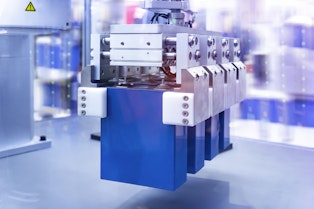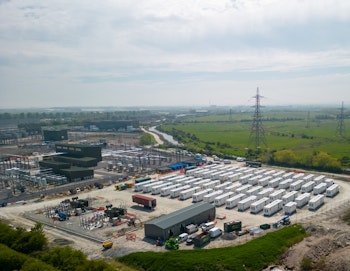There is industry-wide anticipation of a surge in energy storage expansion thanks to the falling cost of lithium-ion batteries. Lower lithium prices will mean better deals and more opportunities for certain sectors of the storage market.
This is welcome news as growth in demand for lithium-ion battery packs, which are key to the electrification of vehicles and many electrical grid storage projects, looked as if it was going to fail to reach the more optimistic industry predictions of the early 2020s.
According to a report from research provider BloombergNEF, the cost of battery packs fell by 14%, towards the end of last year after experiencing unprecedented price hikes in 2022. This significant decrease has enabled the industry to dial back the ‘pause’ policies put in place because of rising costs.
Manufacturers had previously reported lower utilization rates in their plants, with demand and revenue falling short of the expectations of many companies. Additionally, several electric vehicle and battery manufacturers were forced to revisit their production targets.

But now, concerns about sustained high lithium prices have largely disappeared. The recent reduction in price is down to several factors. First gnarly COVID-related supply chain issues are now in the rearview mirror.
Added to this is a fall in the cost of components and raw materials due to expanded production capabilities throughout the battery supply chain. Changes to cathode and anode materials, new pack designs and improved cell manufacturing processes will also be key to future price reductions.
With prices at a historic low of $139 per kilowatt-hour, the BloombergNEF data strongly suggests that the demand for lithium-ion battery packs is set to grow significantly, with a projected year-on-year increase of 53%. Last year saw global lithium-ion battery demand hitting topping 950 gigawatt-hours.
Lower costs mean projects that were put on the backburner may now find a new lease of life. BloombergNEF energy storage analyst Evelina Stoikou suggested initial hopes for lithium-ion technology were too high, but last year saw a significant shift.
She said: “It is another year where battery prices closely followed raw material prices. In the many years that we’ve been doing this survey, falling prices have been driven by scale learnings and technological innovation, but that dynamic has changed.
“The drop in prices this year was attributed to significant growth in production capacity across the value chain in combination with weaker-than-expected demand.”

The $139 per kilowatt-hour figure quoted in the BloombergNEF research is a composite of various battery types across different sectors, including electric vehicles, stationary grid storage and buses. Battery electric vehicle packs, which benefit from a greater production scale, are now at $128 per kilowatt-hour.
At the cell level, average prices for electric vehicle batteries were just $89 per kilowatt-hour. Regionally, the research shows that average battery pack prices were lowest in China, at $126/ per kilowatt-hour. Packs in the US were 11% higher, and in Europe they were 20%.
Historically, the West has favored nickel-manganese-cobalt batteries, although that is changing, while China is dominant in lithium-iron-phosphate (LFP) batteries. BloombergNEF’s analysis found that 2023 was the first year average LFP cell prices had fallen below $100 per kilowatt-hour.
Yayoi Sekine, head of energy storage at BloombergNEF, said: “Battery prices have been on a rollercoaster over the past two years.
“Large markets like the US and Europe are building up their local cell manufacturing and we’re keenly watching how production incentives and tightening regulations on critical minerals will impact battery prices.”

But just how inexpensive can lithium-ion battery storage become? When it comes to electric vehicles, industry analysts have long viewed the $100-per-kilowatt-hour threshold as a crucial milestone, after which cost-competitiveness would be guaranteed.
The US Department of Energy set a more ambitious goal in its 2020 Energy Storage Grand Challenge, aiming for an $80-per-kilowatt-hour manufacturing cost by 2030 (for a 300-mile range electric vehicle).
If prices continue to decline at a similar rate to last year, the industry will easily surpass the $100-per-kilowatt-hour mark within a few years, making the Department of Energy's 2030 target seem highly attainable. A further tailwind is that US policy is being mirrored by regulatory shifts favoring sustainability around the world.
These include new net zero targets and guidelines, including Europe’s ‘Fit for 55’ program, a 2035 ban on new internal combustion engine vehicle sales in the European Union and India’s Faster Adoption and Manufacture of Hybrid and Electric Vehicles scheme.
Throw into the mix increased consumer demand for green technologies plus rising electric vehicle adoption rates and the picture is rosy. According to the International Energy Agency, electric vehicles made up 10% of global vehicle sales in 2022 and are on track to reach 30% by the end of this decade.
Furthermore, commodity data reporting agency Fastmarkets says more than 20 lithium mines opened last year. Expansion of lithium production, which is now expanding to Africa, is good news as mines take between 10 to 15 years to come online.
The price drop in lithium also followed the discovery of a massive reservoir of the metal last year, within an extinct super-volcano on the border of Nevada and Oregon in the US. According to estimates from geologists, the McDermitt Caldera could contain up to 120 million tonnes of lithium.
Canada-based Lithium Americas Corporation intends to start mining operations as early as 2026, with plans to continue extraction for the next 40 years before backfilling the pit.
Even as new lithium reserves are uncovered, the battery industry is working to boost the materials efficiency of its products and improve recycling rates, further safeguarding future lithium-ion battery cost reductions. And for stationary storage, there is the option of even cheaper technologies than lithium-ion.
New technologies are being developed that can store energy in materials as cheap as rust, concrete and air. These concepts are often aimed at delivering large amounts of energy for hours or even days at a time—periods that cannot be covered cost-effectively with lithium-ion today because of the price of the batteries.
If they go mainstream, these technologies could render lithium cost concerns a thing of the past.
Publish date: 26 March, 2024